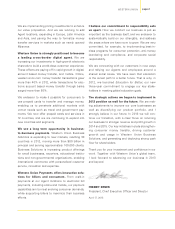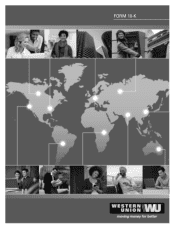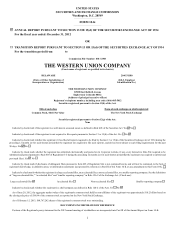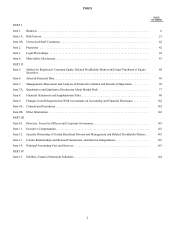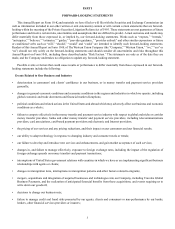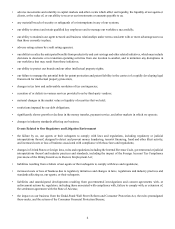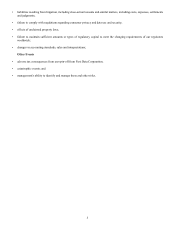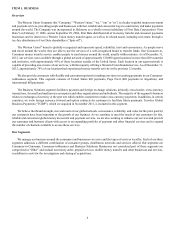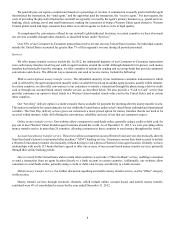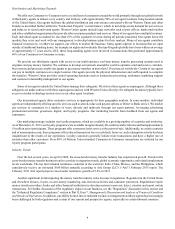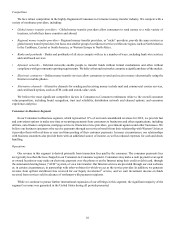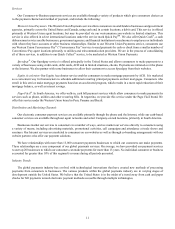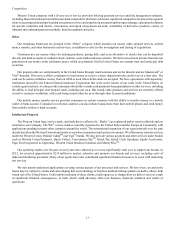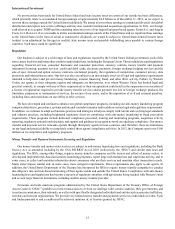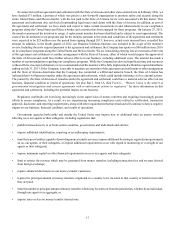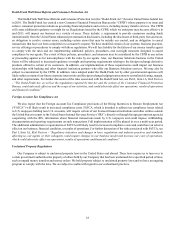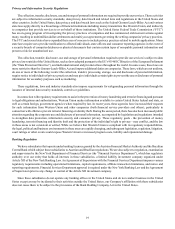Western Union 2012 Annual Report Download - page 14
Download and view the complete annual report
Please find page 14 of the 2012 Western Union annual report below. You can navigate through the pages in the report by either clicking on the pages listed below, or by using the keyword search tool below to find specific information within the annual report.9
Distribution and Marketing Channels
We offer our Consumer-to-Consumer service to millions of consumers around the world primarily through our global network
of third-party agents in almost every country and territory, with approximately 90% of our agent locations being located outside
of the United States. Our agents facilitate the global distribution and convenience associated with our Western Union and other
brands (as described further within the “Intellectual Property” section below), which in turn helps create demand for our services
and helps us to recruit and retain agents. Western Union agents include large networks such as post offices, banks and retailers
and other established organizations that provide other consumer products and services. Many of our agents have multiple locations.
Each individual agent accounted for less than 10% of the segment's revenue during all periods presented. Our agents know the
markets they serve and work with our management to develop business plans for their markets. Many of our agents contribute
financial resources to, or otherwise support, our efforts to market the business. Many agents operate in locations that are open
outside of traditional banking hours, for example on nights and weekends. Our top 40 agents globally have been with us an average
of approximately 17 years and in 2012, these long-standing agents were involved in transactions that generated approximately
60% of our Consumer-to-Consumer revenue.
We provide our third-party agents with access to our multi-currency, real-time money transfer processing systems used to
originate and pay money transfers. We continue to develop our network around the world to optimize send and receive corridors.
Our systems and processes enable our agents to pay money transfers in more than 120 currencies worldwide. Certain of our agents
can pay in multiple currencies at a single location. Our agents provide the physical infrastructure and staff required to complete
the transfers. Western Union provides central operating functions such as transaction processing, settlement, marketing support
and customer relationship management to our agents.
Some of our agents outside the United States manage their subagents. We refer to these agents as superagents. Although these
subagents are under contract with these superagents (and not with Western Union directly), the subagent locations typically have
access to similar technology and services as our other agent locations.
Our international agents often customize services as appropriate for their geographic markets. In some markets, individual
agents are independently offering specific services such as stored-value card payout options or Direct to Bank service. We market
our services to consumers in a number of ways, directly and indirectly through our agent partners, leveraging advertising
promotional activities, grassroots, digital, and loyalty programs. Our marketing benefits from feedback from our agents and
consumers.
Our marketing strategy includes our loyalty programs, which are available in a growing number of countries and territories.
As of December 31, 2012, our loyalty programs were available in approximately 80 countries and territories and had approximately
19 million active participants. These programs offer customers faster service at the point-of-sale. Additionally, in certain countries
and at westernunion.com, these programs offer reduced transaction fees or cash back; however, such redemption activity has been
insignificant to the results of our operations. Loyalty customers generally initiate more transactions and have a higher rate of
retention than other customers. Over 40% of Western Union branded Consumer-to-Consumer transactions are initiated by our
loyalty program participants.
Industry Trends
Over the last several years, except for 2009, the cross-border money transfer industry has experienced growth. Trends in the
cross-border money transfer business tend to correlate to migration trends, global economic opportunity and related employment
levels worldwide. The top four inbound remittance countries in the world are India, China, Mexico, and the Philippines, which
cumulatively receive an estimated $160 billion annually according to Aité Group LLC's (“Aité”) February 2013 report. The
February 2013 Aité report projects cross-border remittance growth of 5.8% in 2013.
Another significant trend impacting the money transfer industry is the increase in regulation. Regulation in the United States
and elsewhere focuses, in part, on anti-money laundering, anti-terrorist activities and consumer protection. Regulations require
money transfer providers, banks and other financial institutions to develop systems to prevent, detect, monitor and report certain
transactions. For further discussion of the regulatory impact on our business, see the “Regulation” discussion in this section and
the “Enhanced Regulatory Compliance” section in Part II, Item 7, Management's Discussion and Analysis of Financial Condition
and Results of Operations. In addition, our ability to enter into or maintain exclusive arrangements with our agents has increasingly
been challenged by both regulators and certain of our current and prospective agents, especially in certain inbound countries.


